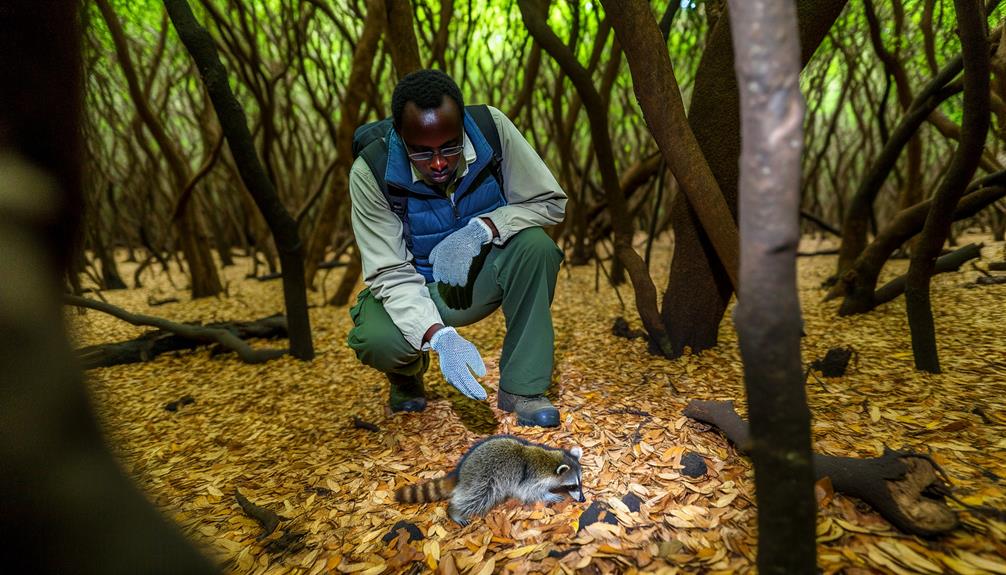How You Get Rabies from a Dead Raccoon and Prevent It
Yes, rabies can be transmitted from a deceased raccoon through contact with its nervous tissues, such as the brain or spinal cord. The virus can survive in the carcass for hours to days, depending on environmental conditions.
Handling a deceased raccoon without appropriate Personal Protective Equipment (PPE) can pose a significant health risk. It is crucial to use gloves and other PPE, and to follow strict disposal protocols to prevent exposure.
If you've had potential contact with a deceased raccoon, seek medical advice immediately for potential post-exposure prophylaxis. Continuing will provide further guidelines on safety measures and preventive actions.

Key Takeaways
- Rabies virus can survive in a deceased raccoon for hours to days, posing a transmission risk.
- Contact with a dead raccoon's brain or nervous tissue can transmit rabies.
- Proper PPE is essential when handling dead raccoons to prevent exposure.
- Securely contain and dispose of the carcass to minimize rabies risk.
- Seek immediate medical advice if exposed to a dead raccoon potentially infected with rabies.
Understanding Rabies
Rabies is a viral zoonotic disease that affects the central nervous system of mammals, including humans. Clinically, it is caused by the Lyssavirus, primarily transmitted through the saliva of infected animals.
The virus travels via peripheral nerves to the brain, resulting in encephalitis and subsequent neurological manifestations. Early symptoms can mimic flu-like conditions, but rapidly progress to acute neurological dysfunction, including agitation, hydrophobia, and paralysis.
Without prompt post-exposure prophylaxis, rabies is almost universally fatal once clinical symptoms appear. The burden of rabies is significant in regions lacking robust public health infrastructure.
Understanding the pathophysiology, clinical presentation, and epidemiology of rabies is essential for healthcare professionals and public health workers dedicated to controlling this preventable, yet deadly, disease.
How Rabies Spreads
Rabies transmission primarily occurs through the bites of infected animals, where the virus is introduced via their saliva.
Additionally, contact with saliva through open wounds or mucous membranes can facilitate the spread of the virus.
Handling infected carcasses without appropriate protective measures also poses a significant risk for rabies exposure.
Transmission Through Bites
Transmission of the rabies virus typically occurs through the introduction of infected saliva into the body via bites or scratches from an infected animal. This zoonotic pathogen primarily targets the nervous system, migrating from peripheral nerves to the central nervous system.
Once clinical symptoms manifest, rabies is almost invariably fatal. The virus's entry is facilitated through breaches in the skin, where it replicates in muscle cells before advancing to neural tissues.
Epidemiological data underscore the critical importance of immediate post-exposure prophylaxis (PEP) following potential exposure. Healthcare providers must remain vigilant in recognizing and treating bite wounds from rabies-susceptible species, such as raccoons, to mitigate the risk of viral transmission and subsequent morbidity and mortality.
Contact With Saliva
In addition to bites, the rabies virus can also be transmitted through contact with the saliva of an infected animal if it comes into contact with mucous membranes or open wounds. This mode of transmission is clinically significant as it emphasizes the need for stringent precautionary measures. Evidence indicates that even small amounts of infected saliva can harbor the virus, posing a significant risk.
For individuals committed to public health and safety, understanding this pathway is vital in developing effective preventive strategies. Protective measures, such as wearing gloves and avoiding direct contact with potentially infected saliva, are paramount. This knowledge empowers healthcare providers and public health professionals to educate communities on minimizing exposure risks and enhancing rabies prevention efforts.
Handling Infected Carcasses
Handling the carcasses of animals infected with the rabies virus presents a notable risk for viral transmission, particularly through exposure to neural tissue and bodily fluids. Rabies is a neurotropic virus, primarily found in the brain, spinal cord, and saliva of infected animals.
When dealing with such carcasses, individuals are at risk if they have open wounds or mucous membrane contact with these tissues. Protective measures, including the use of gloves and masks, are crucial to mitigate this risk.
It is strongly recommended to avoid handling potentially rabies-infected carcasses entirely and to contact local animal control or public health authorities for proper disposal. This approach guarantees safety and minimizes the potential for rabies transmission to humans.
Dead Animals and Rabies
Understanding the risk of rabies transmission from dead animals is essential for both public health and wildlife management. Rabies is primarily transmitted through the saliva of infected animals via bites or scratches. However, the virus can persist in neural tissues post-mortem, especially in cooler temperatures.
Direct contact with brain tissue or other nervous system components of a dead animal poses a potential risk. This necessitates stringent protocols for handling and disposing of carcasses, particularly those of rabies-susceptible species. Personal protective equipment (PPE) and thorough decontamination are critical in mitigating exposure risks.
Evidence-based guidelines emphasize minimizing contact and ensuring proper disposal methods to prevent inadvertent transmission, thereby safeguarding both human health and ecological stability.
Risks From Dead Raccoons
Understanding the risks associated with dead raccoons requires examining the rabies virus's survival time outside a host. The importance of safe carcass handling is paramount in ensuring the containment of potential transmission risks. Identifying signs of rabies infection is crucial for taking appropriate measures to safeguard against exposure.
The rabies virus can remain viable in a deceased animal for a limited period, necessitating precautions during disposal. Proper handling techniques and recognition of rabies symptoms are critical for mitigating potential health hazards.
Rabies Virus Survival Time
The survival time of the rabies virus in a deceased raccoon is influenced by environmental factors such as temperature and humidity, which can greatly impact the risk of transmission. Under best conditions, the rabies virus can remain viable in a carcass for several hours to a few days.
Cooler temperatures and high moisture levels can prolong the virus's survival, whereas heat and drying tend to inactivate it more rapidly. Studies indicate that the virus is more stable in colder climates, posing a higher risk of transmission in these environments.
Understanding these dynamics is vital for evaluating potential exposure risks and implementing appropriate safety measures to prevent infection. Proper education and adherence to protocols can greatly reduce the dangers posed by rabies.
Handling Carcass Safely
When dealing with the carcass of a potentially rabid raccoon, strict adherence to safety protocols is vital to mitigate the risk of viral transmission. Handling such carcasses requires the implementation of stringent protective measures to prevent direct contact with bodily fluids, which can harbor the rabies virus.
Key safety guidelines include:
- Personal Protective Equipment (PPE): Utilize gloves, masks, and protective clothing to avoid direct skin contact.
- Disinfection: Thoroughly disinfect any tools or surfaces that come into contact with the carcass using appropriate antiviral agents.
- Proper Disposal: Follow local regulations for the disposal of animal remains, ensuring they are securely contained and transported to prevent environmental contamination.
These precautions are essential for safeguarding public health and preventing the spread of rabies.
Signs of Rabies
Identifying the signs of rabies in a deceased raccoon is important for evaluating the potential risks of viral transmission to humans and other animals. Clinically, rabies in raccoons manifests through neurological symptoms such as agitation, aggression, and excessive salivation.
Post-mortem, these signs can be inferred through physical examination and histopathological analysis of brain tissue. Negri bodies, eosinophilic inclusions found in neurons, are indicative of rabies infection. Additionally, PCR testing of tissue samples can confirm the presence of the rabies virus.
While a dead raccoon presents lower transmission risks compared to a live one, direct contact with bodily fluids, particularly brain tissue, remains hazardous. Proper protective measures and diagnostic confirmation are essential for minimizing human and animal health risks.
Symptoms of Rabies
Clinically, rabies manifests through a progression of neurological symptoms that typically begin with fever and discomfort at the site of exposure.
As the virus advances, it targets the central nervous system, leading to more severe manifestations. Early symptoms often mimic those of other illnesses, making initial diagnosis challenging.
Common symptoms include:
- Neurological disturbances: Hyperactivity, confusion, hallucinations, and agitation.
- Hydrophobia and Aerophobia: Severe throat spasms triggered by swallowing or exposure to air.
- Paralysis: Progressive paralysis, culminating in respiratory failure.
These symptoms advance rapidly, often resulting in coma and death if untreated. The incubation period can vary from weeks to months, influenced by factors such as the site of exposure and viral load.
Immediate medical intervention is essential for potential rabies exposure.
Safe Handling Practices
Given the severity and fatal progression of rabies, it is crucial to adopt stringent safe handling practices when dealing with potentially infected animals, including deceased ones. The rabies virus can persist in the nervous tissue of a dead animal for a variable period, posing a significant risk of transmission.
It is essential to minimize direct contact with the animal's carcass. Utilize tools such as shovels or tongs to handle the body and make sure that it is securely contained in a double-layered, leak-proof bag. Promptly report the incident to local health or wildlife authorities for proper disposal and testing.
Additionally, thoroughly disinfect any surfaces or tools that might have come into contact with the animal to prevent potential contamination.
Protective Gear to Use
When handling a deceased raccoon, it is crucial to use appropriate protective gear to minimize the risk of rabies transmission. This includes wearing gloves for hand protection, utilizing face masks to prevent inhalation of aerosolized particles, and adhering to safe disposal practices to guarantee environmental and personal safety.
Evidence-based guidelines emphasize the critical role of these measures in mitigating potential health hazards.
Gloves and Hand Protection
Proper gloves and hand protection are important when handling a dead raccoon to minimize the risk of rabies transmission and other zoonotic infections. Utilizing appropriate protective gear is vital for ensuring safety and preventing contamination.
Evidence-based recommendations advocate for the use of durable, impermeable gloves that provide a strong barrier against pathogens.
- Latex or Nitrile Gloves: These materials offer excellent resistance to punctures and chemicals, ensuring a reliable barrier.
- Double Gloving: Wearing two layers of gloves can provide extra protection in the event of a tear or puncture.
- Proper Disposal: Ensuring gloves are disposed of following biohazard protocols further reduces the risk of inadvertent exposure.
Adhering to these guidelines greatly improves safety during raccoon handling procedures.
Face Masks Importance
Utilizing face masks is important in preventing the inhalation of aerosolized pathogens when handling a dead raccoon. This protective measure is vital as pathogens such as the rabies virus can be present in the saliva and neural tissues of deceased animals. Studies underscore that aerosolized particles pose a risk, particularly during the handling or transport of carcasses. By using face masks not only safeguards the handler but also mitigates potential public health risks.
| Type of Mask | Filtration Efficiency | Recommended Use |
|---|---|---|
| N95 Respirator | 95% | Handling high-risk carcasses |
| Surgical Mask | Moderate | General handling |
| Cloth Mask | Variable | Minimal risk scenarios |
Appropriate mask selection guarantees the best protection based on the context of exposure.
Safe Disposal Practices
To safeguard the safe disposal of a deceased raccoon, it is crucial to wear appropriate protective gear, including gloves, face masks, and disposable coveralls, to minimize the risk of pathogen exposure. The Centers for Disease Control and Prevention (CDC) recommend these protective measures to prevent contact with potentially infectious materials.
Proper disposal practices are essential in reducing the transmission of zoonotic diseases such as rabies.
Protective gear to utilize includes:
- Gloves: Use heavy-duty, puncture-resistant gloves to avoid direct contact with the animal.
- Face Masks: Employ N95 face masks to filter airborne pathogens.
- Disposable Coveralls: Wear coveralls to prevent contamination of clothing and skin.
Adhering to these guidelines guarantees safe handling and disposal, safeguarding public health.
Proper Disposal Methods
When disposing of a dead raccoon, it is important to follow established guidelines to minimize the risk of rabies transmission and safeguard public health. Utilize personal protective equipment (PPE) such as gloves and masks to prevent direct contact with the carcass. Double-bag the raccoon in heavy-duty plastic bags, making sure to create a tight seal to prevent leakage. Transport the bagged carcass to a designated disposal facility, such as a landfill or animal control center.
| Step | Action | Purpose |
|---|---|---|
| 1 | Wear PPE | Prevents direct contact and potential infection |
| 2 | Double-bag carcass | Secures carcass, prevents leakage |
| 3 | Transport to disposal facility | Ensures safe and proper disposal |
Following these procedures guarantees public safety and environmental protection.
When to Call Authorities
In instances where a deceased raccoon is found in residential areas or poses a potential health hazard, reaching out to local animal control or public health authorities is crucial. Prompt reporting guarantees the safe and efficient handling of potentially infectious animals, reducing risks associated with zoonotic diseases such as rabies. Authorities are equipped to manage these situations using evidence-based protocols, minimizing public health threats.
Key reasons to contact authorities include:
- Disease Control: Deceased raccoons can harbor pathogens, requiring professional evaluation to prevent disease transmission.
- Public Safety: Authorities can secure areas to prevent human and pet exposure.
- Proper Disposal: Professionals make sure that the carcass is disposed of following legal and sanitary guidelines.
Engaging with authorities assists in maintaining community health and safety.
Cleaning Contaminated Areas
Cleaning areas contaminated by a deceased raccoon requires adherence to strict biosecurity protocols to mitigate the risk of zoonotic disease transmission. Initially, personnel must wear appropriate personal protective equipment (PPE), including gloves, masks, and eye protection.
Surfaces should be disinfected using an EPA-registered disinfectant effective against rabies virus. All organic material, such as blood or tissue, must be cautiously removed and disposed of following local health department regulations. Contaminated porous materials, like carpeting, may need to be discarded if thorough decontamination is unattainable.
Non-porous surfaces should be cleaned with soap and water prior to disinfection. Post-cleaning, all PPE should be properly disposed of, and hands should be washed with soap and water. Following these guidelines guarantees the safety of both individuals and the community.
Preventive Measures
To minimize the risk of rabies transmission from deceased raccoons, implementing thorough preventive measures is crucial. These measures are essential for public health safety and guaranteeing minimal exposure to the rabies virus.
Evidence-based strategies include:
- Personal Protective Equipment (PPE): Utilize gloves, masks, and eye protection when handling carcasses to prevent direct contact with potentially infectious material.
- Proper Disposal: Adhere to local health department guidelines for the disposal of dead raccoons, including the use of sealed, leak-proof containers.
- Vaccination: Make sure that all individuals at risk, including wildlife handlers and veterinarians, are up-to-date with rabies vaccinations.
These steps are critical in mitigating the risk of rabies, safeguarding public health, and maintaining a secure environment.
Seeking Medical Advice
Consulting with a healthcare professional is essential if you suspect exposure to rabies from a deceased raccoon. Rabies is a fatal viral disease, and timely medical intervention is vital. Healthcare providers will assess your risk based on the nature of contact and potential contamination.
Post-exposure prophylaxis (PEP), involving rabies immunoglobulin and a series of rabies vaccinations, may be recommended. It is important to adhere to the prescribed treatment regimen promptly to mitigate the risk of developing rabies.
Additionally, report the incident to local health authorities to guarantee public safety measures are in place. Remember, early medical consultation can be life-saving, as rabies, once symptomatic, is almost invariably fatal. Prioritize immediate medical evaluation following any potential rabies exposure.
Conclusion
Coincidentally, understanding the transmission of rabies reveals that dead raccoons, while less likely to spread the virus, still pose a risk.
Rabies, a neurotropic virus, primarily transmits through direct contact with the saliva of infected animals. Dead animals may harbor the virus, particularly in their neural tissues.
Hence, appropriate caution, including avoiding contact, notifying authorities, and proper sanitation, is essential.
Medical consultation should be sought if exposure is suspected to mitigate potential health risks effectively.






